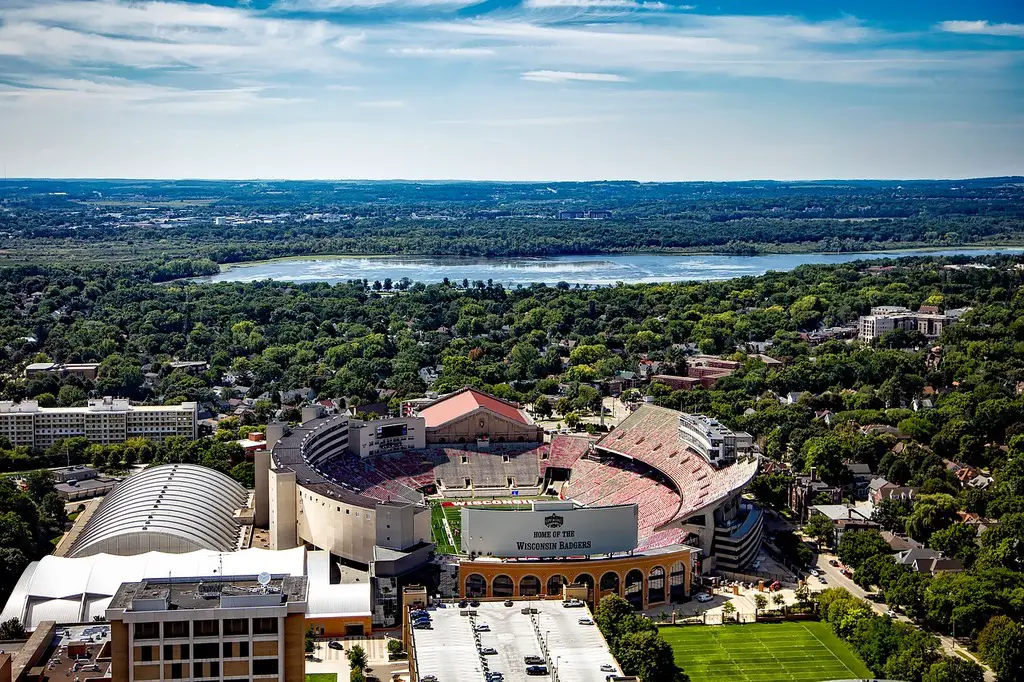Ah, summer—the season of sunburns, iced coffee, and pretending mosquitoes are your only problem. But plot twist: ticks are out here living their best lives, too. And unlike your ex, they actually ghost you after stealing something important—like your health. These tiny creepers are no longer just a forest problem; they’ve rolled up to cities, backyards, and hiking trails like uninvited guests at your summer picnic.
With longer warm seasons and changing habitats, tick-borne diseases like Lyme, anaplasmosis, and even meat allergies (yep, that’s a thing now) are creeping into more places than ever. So before you head out for that nature walk or backyard BBQ, check this list of U.S. cities on high alert. Some of them might surprise you—and no, bug spray alone isn’t gonna cut it anymore.
1. Madison, Wisconsin

Cheese, lakes, and now… ticks? Yep, Madison is facing a serious rise in tick-borne illnesses, particularly Lyme and anaplasmosis. The Wisconsin Department of Health warns that blacklegged ticks are expanding into new regions across the state every year. And per Spectrum News, the Midwest is experiencing one of the fastest upticks (sorry) in reported cases.
Madison’s lush green spaces and trail-filled culture make it a prime target. Ticks lurk in the brushy edges of hiking paths and in tall grass—so that adorable afternoon bike ride could come with an uninvited passenger. Even pets are at risk, and local vets have seen an increase in tick-borne illnesses in dogs. So yeah, if you’re frolicking in the arboretum or tailgating in shorts, double-check your socks when you get home. The local vibe is still wholesome Midwest—but the ticks are out here freeloading like it’s their full-time job.
2. Poughkeepsie, New York

Nestled in the tick-plagued heart of the Hudson Valley, Poughkeepsie has basically become the Coachella of Lyme disease. The blacklegged tick (aka the infamous deer tick) thrives here, and cases have consistently spiked in recent years. According to the Dutchess County Dept of Health, Dutchess County (where Poughkeepsie is located) ranks among the top U.S. counties for Lyme disease incidence. Spoiler alert: this isn’t the kind of #1 spot you want.
The combo of dense woodlands, mild winters, and abundant deer basically makes it a tick paradise. And no, just staying in the city center won’t save you—ticks don’t care about your iced coffee run. Even neighborhood parks can be hotspots. Locals are advised to rock long sleeves, do tick checks like it’s a skincare routine, and maybe rethink those barefoot strolls through the grass. It’s still gorgeous and historic—but bring repellent unless you want your souvenir to be Borrelia burgdorferi.
3. Asheville, North Carolina

Asheville might be the dream for artsy hikers and bluegrass-loving free spirits, but it’s also a rising hotspot for tick-borne disease. With milder winters and longer summers, tick populations here are thriving. According to a Washington Post feature on climate shifts and tick spread, the Southeast is seeing an influx of lone star ticks and even Gulf Coast ticks moving inland. Asheville’s beautiful Blue Ridge surroundings? Also prime tick real estate.
The problem isn’t just Lyme. Southern ticks bring different baggage—like ehrlichiosis and STARI (southern tick-associated rash illness), which mimic Lyme but don’t respond quite the same to treatment. Add in Asheville’s booming population of hikers and outdoor lovers, and you’ve got a whole lot of potential exposure. Local health officials recommend daily tick checks, especially on kids and pets, and spraying your socks like it’s 2004 mosquito season. Ticks love damp, shaded, overgrown areas—aka every dreamy nature shot in your camera roll. Stay outdoorsy, just maybe not barefoot.
4. Pittsburgh, Pennsylvania

Steel City has always been tough—but ticks don’t care about grit. Pittsburgh and the surrounding Allegheny County have seen a noticeable rise in Lyme disease over the past decade. As reported by Stat News, northern tick-borne illness rates are surging as ticks creep deeper into cities, suburbs, and beyond. And Pittsburgh’s lush hills and wooded parks give ticks exactly what they’re looking for.
Even urban neighborhoods with backyard gardens or dog runs are at risk. Ticks don’t need wilderness anymore—just a little overgrowth and a warm body. The Pennsylvania Department of Health has issued recurring seasonal alerts and recommends treating clothing and gear with permethrin before heading outside. City folks often forget they’re living on the edge of nature—until nature bites back. Pittsburgh may be built on steel, but your ankles are not. Cover up and keep that lint roller handy.
5. Minneapolis, Minnesota

The Twin Cities are getting an unwanted plus-one this summer: blacklegged ticks are thriving thanks to shorter winters and more humid summers. Lyme disease isn’t new to Minnesota, but it’s way more common than it used to be. As KARE 11 reported, 2023 saw a significant rise in confirmed Lyme cases across the state, with the Minneapolis metro area seeing the steepest growth.
Ticks are no longer just hanging out in remote forests—they’re venturing into suburban lawns and local parks. Popular hiking trails, like those around the Mississippi River or Chain of Lakes, are hotbeds for potential exposure. Experts recommend tucking pants into socks (yes, you’ll look wild, but you’ll thank yourself later), and showering immediately after outdoor activities. And don’t skip tick checks just because you’re close to home—urban ticks are just as thirsty. Minneapolis may be chill, but the ticks are getting bold. Swat smart, not scared.
6. Portland, Maine

Portland might be all lobster rolls and lighthouses on the outside, but this coastal gem is crawling with a less delicious summer staple: ticks. Maine has quietly become one of the most Lyme-saturated states in the country, and Portland’s woodsy neighborhoods and popular trails make it a prime tick destination. The blacklegged ticks here don’t mess around—they’re small, sneaky, and love a well-shaded sock line. Even backyard gardens in suburban areas can be tick playgrounds. The kicker? It’s not just Lyme—babesiosis and anaplasmosis are now on the rise, too.
Locals joke that tick checks are basically foreplay now, and honestly… they’re not wrong. Hiking the Presumpscot River Trail or walking your dog in Deering Oaks? You better be spraying up and checking down. Ticks aren’t just a “deep woods” problem anymore—they’re chilling in the ferns behind your garage. Portland may look quaint, but its ticks are ready to party. And by party, we mean sneak into your bloodstream and mess with your immune system.
7. Burlington, Vermont

Maple syrup isn’t the only thing flowing through Vermont these days—so are cases of tick-borne illnesses. Burlington’s leafy charm and eco-friendly outdoorsiness make it easy to forget that ticks love this climate. Between its humid summers, deer-filled trails, and high grass galore, Burlington is a blacklegged tick’s dream Airbnb. And while Lyme has been Vermont’s mainstay for years, newer illnesses are creeping in, too.
Locals pride themselves on being outdoorsy, but many are adding permethrin to their gear just as casually as SPF. It’s not uncommon to see hikers in long sleeves in July, and that’s not just a fashion statement—it’s self-defense. Even picnicking on the lawn at Waterfront Park can leave you itchy and paranoid. Burlington may be one of the most wholesome towns in the U.S., but don’t let that green beauty fool you. There’s a war under the grass, and the ticks are winning.
8. Richmond, Virginia

Richmond brings the Southern charm, but also the Southern ticks. As temperatures rise, so do encounters with lone star ticks, which are infamous not just for bites, but for triggering that weird red meat allergy. (Yes, really.) The city’s green belts and river trails make it a go-to for outdoor lovers, but those same lush spaces double as tick resorts. You don’t even need to leave downtown—ticks are creeping into city parks and residential yards alike.
Locals have caught on and are arming themselves with DEET, long socks, and an eagle eye. Dog owners especially are on high alert—ticks love your pets just as much as they love you. And yes, you can get a tick bite while sipping a craft beer on a picnic blanket. Richmond’s gorgeous, but its ticks are not playing around this year. A little prevention goes a long way—because waking up allergic to burgers is a summer plot twist no one asked for.
9. Providence, Rhode Island

Don’t let its small size fool you—Rhode Island packs a punch when it comes to tick trouble. Providence, in particular, has become a hotbed for blacklegged ticks, and the state’s tight combo of forest, marsh, and suburban sprawl gives these parasites a lot of turf to explore. Lyme disease rates here are no joke, and cases tend to peak in the warm months when everyone’s out hiking, gardening, or trying to look whimsical in linen.
Tick-borne babesiosis is also making a name for itself in the region, which feels deeply unfair—like, wasn’t one mystery illness enough? Locals have started doing routine tick checks on kids, pets, and themselves before they even leave the park. Backyard BBQ? Better check your ankles before you serve the burgers. Providence is charming, sure, but behind all that charm is a tick population with main character energy. Think of it like this: if you’re going to enjoy all that green space, you’ve got to dress like you’re going to battle.
10. Nashville, Tennessee

Nashville’s honky-tonk streets and humid trails are the perfect combo—for both tourists and ticks. Lone star ticks in particular are out in full force across the region, and they’re not just biting—they’re making people allergic to bacon, brisket, and all your BBQ dreams. (Honestly cruel, given the city’s food scene.)
Ticks here don’t require wilderness—they’ll show up in overgrown lawns, dog parks, even roadside grass. As the city sprawls outward, more folks are running into tick territory without realizing it. Local hikers are learning to treat their boots like armor, and even short walks through Percy Warner Park now come with a post-hike tick inspection. You might be in the heart of country music, but these ticks are writing their own horror songs. Bottom line: the only bites you want this summer are hot chicken—not insect-born diseases.
11. Concord, New Hampshire

If you thought New Hampshire’s “Live Free or Die” motto didn’t apply to ticks, well… they’re definitely living free. Concord’s gorgeous woods and mountain views are also some of the most tick-rich parts of New England. Lyme disease has been a recurring issue here, but newer threats like Powassan virus are also getting whispered about among health officials.
Despite its serene vibe, Concord is in the thick of tick territory. Families doing wholesome hikes or tending to backyard gardens are reporting more bites than ever. The tick situation has gotten serious enough that local clinics now offer full tick removal kits at the pharmacy. If you’re enjoying the great outdoors here, don’t just pack snacks—pack tweezers and DEET. These ticks are sneaky, and they don’t take weekends off. Consider bug spray your new state flower.
12. Rochester, New York

Upstate New York may not be the first place you think of for tick danger, but Rochester is here to say: surprise! Once mostly associated with winter woes, the city now has hot, humid summers that ticks love. Residents are noticing more blacklegged ticks every year, especially in grassy suburban areas and wooded walking trails. Lyme disease cases have been steadily rising, and outdoor enthusiasts are getting savvier about their prep.
Pet owners in particular have become tick-check pros, with local vets sounding the alarm on infections spreading from tick bites. Even urban parks like Highland and Cobbs Hill are seeing an uptick (pun intended) in tick sightings. Rochester is green, beautiful, and family-friendly—but don’t let that lull you into skipping protection. A single tick bite can come with a summer of regret. Pro tip: long socks, light clothes, and a lint roller in your trunk are not overkill.
13. Hartford, Connecticut

Ah, Connecticut—the land of preppy vibes, colonial charm, and apparently, some of the highest tick rates in the country. Hartford is no exception. Nestled in a region thick with woodlands and deer populations, the city sits smack in the crosshairs of tick country. While Lyme has long been a known enemy here (it literally gets its name from a nearby town), newer illnesses like babesiosis and anaplasmosis are quietly gaining traction.
And let’s not even start on Powassan, a rare but scary virus that’s also spread by ticks in the region. Hartford residents are increasingly turning to treated clothing and even yard services to manage the problem. Every dog park visit is a calculated risk, and garden strolls feel like tactical missions. The city has beauty, history, and good coffee—but don’t be fooled, it’s also a tick epicenter. Connecticut’s preppy charm comes with a side of tiny, disease-carrying stowaways.
14. Kansas City, Missouri

Tucked in the Midwest and proud of its BBQ, Kansas City has quietly joined the tick-borne disease conversation. Lone star ticks are spreading here like they’re on a press tour, and they’re bringing weird side effects like red meat allergies with them. KC’s sprawling green spaces and humid summers make it a perfect breeding ground for ticks, even in residential neighborhoods.
Local hikers, gardeners, and dog parents have all reported a surge in bites—many from tick species that weren’t even in the area a decade ago. Climate changes and growing suburban sprawl have given ticks a free ride into areas that once seemed safe. Now, every trip to the park requires a little extra planning and a lot more bug spray. Kansas City might be famous for its food, but these ticks are aiming to take it off your plate—literally. So yeah, wear the long pants. Your brisket-loving future self will thank you.
